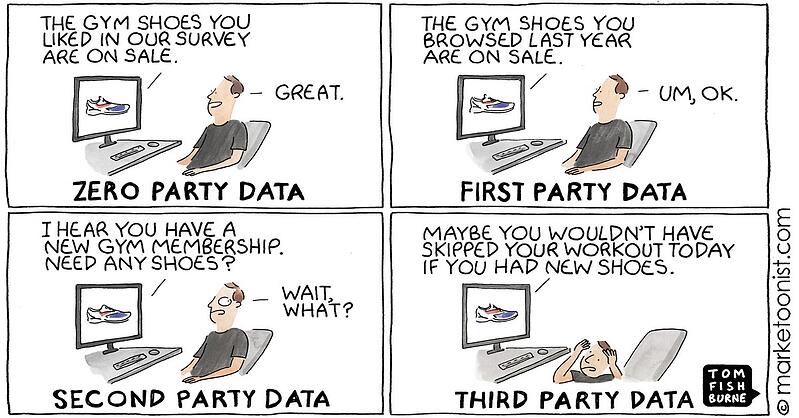Apple’s ATT rollout is a huge blow to advertisers. Increased costs, inefficient user targeting, and new privacy measures have made it challenging to track attribution on paid social.
So, what’s next for advertisers?
Is this the end of personalized advertising as we know it?
Or, is it a much needed pivot to owned data?
Apple’s ATT: A brief recap
Upholding its commitment to privacy, Apple rolled out its ATT (App Tracking Transparency) framework allowing users to opt-out of tracking.
This means users have to opt in to IDFA (identifier for advertisers) tracking, and advertisers must disclose how the data collected will be used.

Most companies are reporting varying opt-in rates, but the real problem is if you can’t track attribution accurately, can you justify your ad spend?
Facebook’s new automated ad tracking to counter data lost
A major implication of Apple’s ATT is having fewer audience insights to work with to run Facebook ads.
Facebook has rolled out new updates, including making new changes to its API update.
To help advertisers find additional opportunities that weren’t originally available to them, when advertisers leverage Detailed Targeting and optimize for conversions, value or app events using the conversions objective they will be automatically included into Targeting Expansion.
Targeting Expansion will allow advertisers to show ads to a broader audience that fits their specifications.

Using the Targeting Expansion feature may include audiences that are not relevant to increasing your ad spend without improving your conversions.
Marketers will have to re-learn measurement
Ionut Ciobotaru, Chief Product Officer at Verve Group, believes marketing measurement needs a facelift.
First, inventory is going to be mostly sold without identifiers. Attribution will shift to probabilistic approaches that rely far more on econometrics and media mix modeling than they do today. Second, first-party data and direct user relationships will become more valuable than ever. They will help improve conversion modeling within each channel, increasing the effectiveness of media buying.
This is good news for brands that rely on owned data, but for brands that center their strategies on media buys on web and mobile, existing strategies have to be completely scrapped.
iOS 15 is going to rock the boat for advertisers AGAIN

Advertisers have barely had a chance to discover the long-term effects of ATT and how advertising on various platforms has been affected.
Will Crocker Hay, VP of customers and partner marketing at Braze, said, “iOS 15 is certainly going to rock the boat for marketers across the world if they are unprepared.”
The iOS 15 release is a good time to check in with users to understand their behavior towards tracking and privacy.

Hay also said,
Marketers need to ensure that they're only requesting absolutely necessary permissions and communicating with transparency around how they're going to use those permissions to enhance the user’s experience and maintain trust.
The only caveat is that total obfuscation of device-level identity may become the standard. Making sure that ads are relevant, engaging, and personalized at scale seems like a mammoth task.
The road ahead: Can you create personalized ads without sacrificing user privacy?
Apple is not the only flagbearer of user privacy. Google’s Privacy Sandbox that will render cookies useless also has advertisers worried about the future.
Navigating the post-cookie world will be difficult but not impossible.
Attain first-party data
Some brands will have to work harder than others to gather first-party data. Automotive and CPG brands have limited consumer interactions, whereas travel and financial services have frequent and direct access to consumers.

Rapid A/B testing
The answer to limited access to owned data may be rapid and automated A/B testing. Work with user personas based on owned data and use Facebook’s dynamic creative to swap out different elements.

Advanced personalization at scale
While Facebook’s dynamic creative is good, it cannot help you personalize at scale.
Imagine you’re a brand that wants to display personalized ads based on the location.
You could do it manually for a single location but try doing it for hundreds of locations with updated data and you’ll understand that it’s not just difficult; it’s impossible.
That’s where platforms like Hunch can help. All you have to do is connect your feed, and we automate ad creation and media buying for you.
Shift in measurement
Wulfric Light-Wilkinson, GM EMEA of Wunderkind, believes that marketers will need to move away from top-level metrics like impressions, reach and open rates and focus on revenue attribution instead.
The future is “less data; more modeling,” according to Alex Davies, VP of Analytics at Jellyfish.
But it doesn’t make any of this easy. Wrapping your brain around the latest updates and trying to ensure your ad dollars are being spent well is a constant battle.
At Hunch, we believe that you should focus on what truly matters - growing your business. As a certified Facebook technology partner, we’ve run hundreds of successful campaigns for some of the biggest brands, and we can use those insights to help you.
Book your free strategy call to see our post-cookie and ATT playbook in action.



